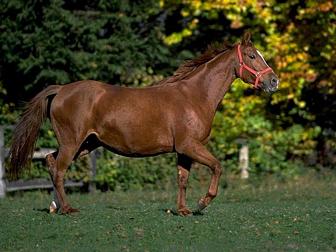
OVERVIEW
The New Forest Pony has an unusual background for a native pony breed. These ponies have existed for over a thousand years in what is termed the "New Forest" region of southern England, and what is really one of the largest unenclosed tracts of open expanse in that area of the country rather than "forest" land. Although efforts have been made since the 1930s to standardize a "type," the New Forest Pony is really an amalgamation of many different breeds that have been turned loose in the New Forest Commons over the years, leading to a wide range of sizes and shapes.
PHYSICAL DESCRIPTION
One of the larger of Britain's native breeds, standing around 14.2 hh, the New Forest makes an excellent all-around equine. It generally has a large head with large, intelligent eyes. It has a shortish neck with good shoulder and short back. It is also marked with strong loins and hindquarters, and strong, hard legs with excellent hooves. Due to the mixed background of the pony, the breed is separated into two types: type A is lighter in bone and stands up to 13.2 hh, and is better suited as a child's hunter and riding pony. Type B is a larger pony, standing up to 14.2 hh, and is suitable for adult riding.
ORIGIN
Records as early as 1016 show evidence of horses, cows, and other animals present in the New Forest. At that time, and for centuries following, this area was a Royal hunting ground with Rights of Common Pasture granted to those living within or on the outskirts of the area. Over the years many breeds and types were turned loose over the commons, including Welsh, Thoroughbred, Arab, and Hackney. Attempts at refining the ponies were explicitly made in 1765 with the use of the Thoroughbred, Marske, and in the late 1850s when Queen Victoria lent an Arab, Zorah, to feudal caretakers. Later, Highlands Ponies, Fells, Dales, Dartmoors, Exmoors and other Welsh stock was brought in to improve the New Forest blood. It wasn't until the 1930s, however, that the New Forest Pony and Breeding and Cattle Society disallowed outside blood in an attempt to create a uniform type of New Forest breed.
INTERESTING FACTS
There is no question that the New Forest Pony has been improved as a result of outside blood, but it has also brought about a pony whose type is not always readily distinguishable. Some "improvements," although refining the pony, actually created problems for those horses not able to cope with the sparse winter feed. All in all, the modern New Forest Pony is a exceptional all-around pony, with a definite character taken from its environment.
INFLUENCES
1. Celtic Pony
2. Thoroughbred
3. Arabian
For more information:
The New Forest Pony Breeding & Cattle Society
New Forest Pony Association Inc. & Registry